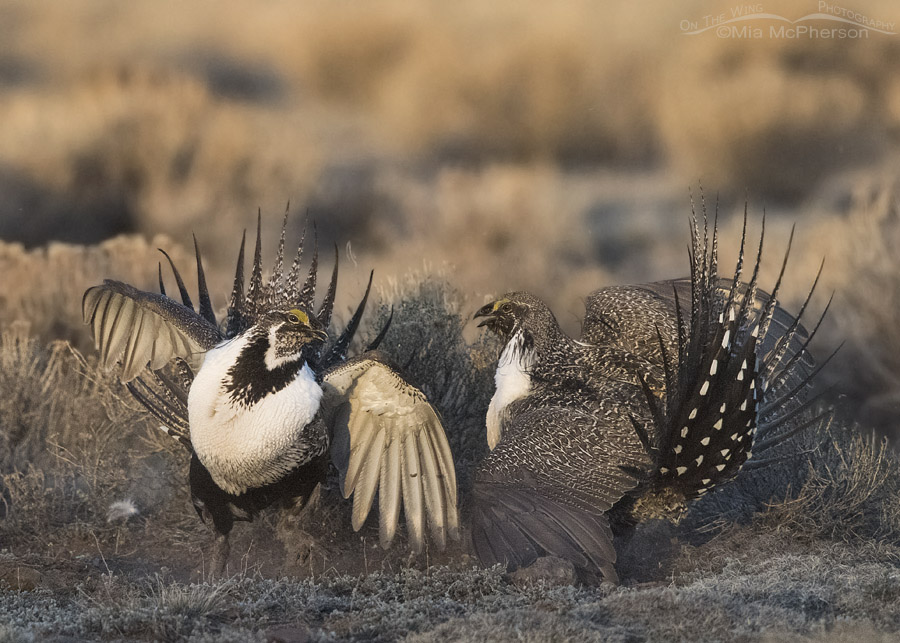 Battling male Greater Sage-Grouse – Nikon D810, f6.3, 1/2500, ISO 6400, Nikkor 500mm VR with 1.4x TC, natural light
Battling male Greater Sage-Grouse – Nikon D810, f6.3, 1/2500, ISO 6400, Nikkor 500mm VR with 1.4x TC, natural light
It was 21°F one frigid morning on a Greater Sage-Grouse Lek and before dawn broke the grouse began to display on the high country sagebrush steppe in Wayne County, Utah.
I was dressed warmly and had fleece under layers on and the cold still caused me to shiver inside the vehicle I was in that was being used as a blind. I started photographing before the sun came over the horizon but honestly I was much happier with the image quality I got after the sun started to shine on the grouse in front of me.
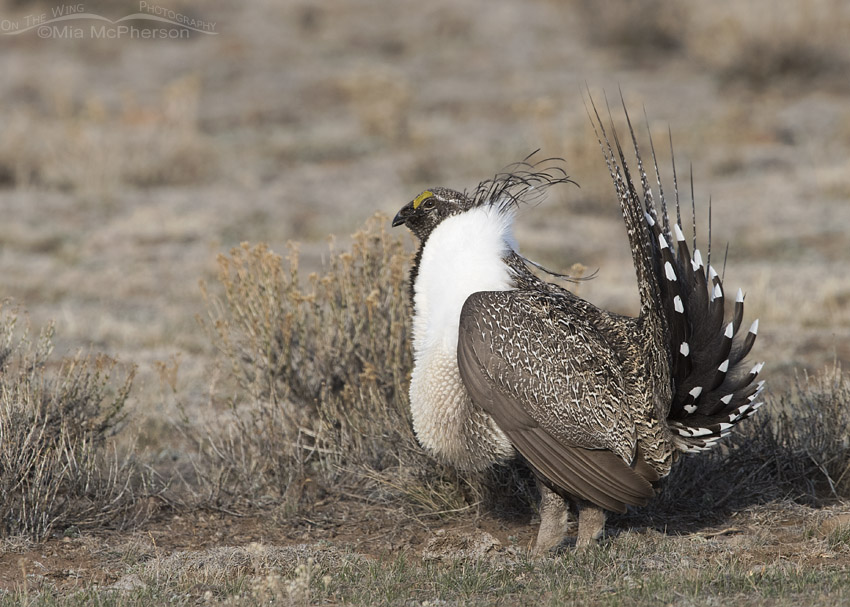 Strutting male Greater Sage-Grouse – Nikon D810, f8, 1/500, ISO 400, Nikkor 500mm VR with 1.4x TC, natural light
Strutting male Greater Sage-Grouse – Nikon D810, f8, 1/500, ISO 400, Nikkor 500mm VR with 1.4x TC, natural light
My Nikon D810 handled the high ISO’s well but as soon as I could I changed to lower ISO’s to obtain better quality images of the yearly mating display of the Greater Sage-Grouse on their lek. Only the best “dancer” mates with the females so the males put on quite a show for them.
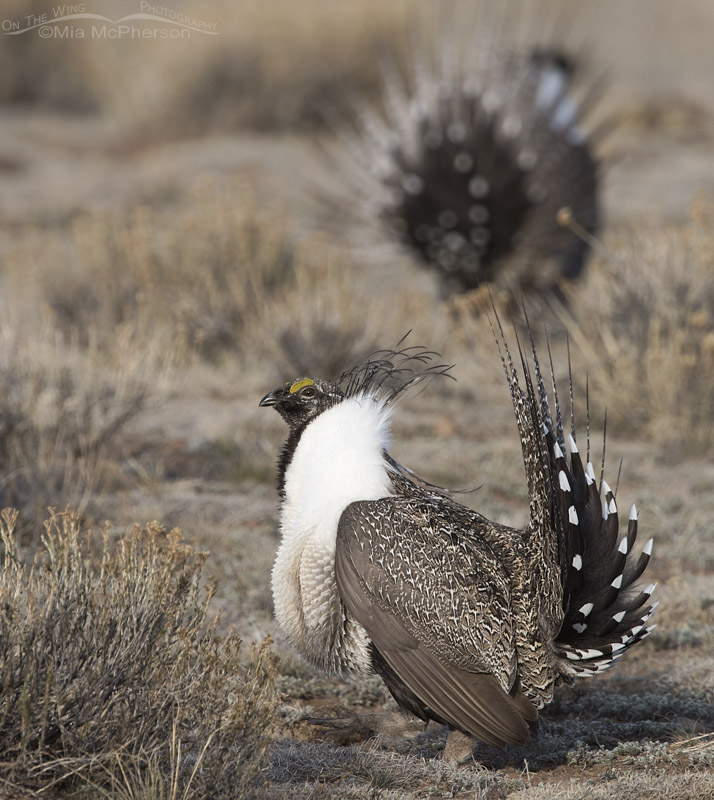 Two Greater Sage-Grouse displaying mating behavior – Nikon D810, f8, 1/640, ISO 400, Nikkor 500mm VR with 1.4x TC, natural light
Two Greater Sage-Grouse displaying mating behavior – Nikon D810, f8, 1/640, ISO 400, Nikkor 500mm VR with 1.4x TC, natural light
They fan their tails and strut, raise their filoplumes (wispy feathers behind their heads) and yellow eye-combs and gulp in as much as one gallon of air to make their strange but delightful “plopping” calls.
Listen to the calls here.
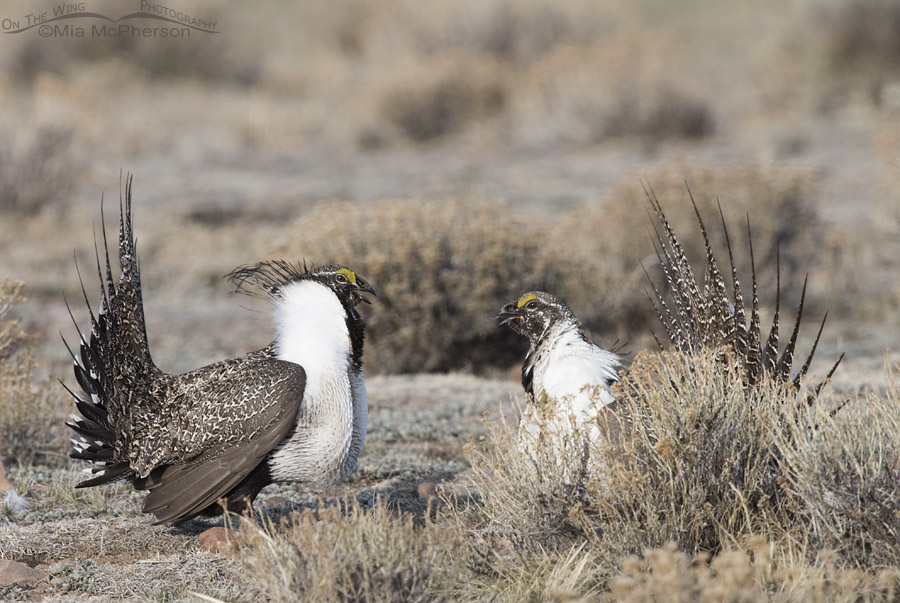 Male Greater Sage-Grouse facing each other head on – Nikon D810, f8, 1/640, ISO 640, Nikkor 500mm VR with 1.4x TC, natural light
Male Greater Sage-Grouse facing each other head on – Nikon D810, f8, 1/640, ISO 640, Nikkor 500mm VR with 1.4x TC, natural light
The male Greater Sage-grouse faced each other often while I photographed them with frozen fingers and I knew that when they did that one of two things would happen, the first being one male might just walk away…
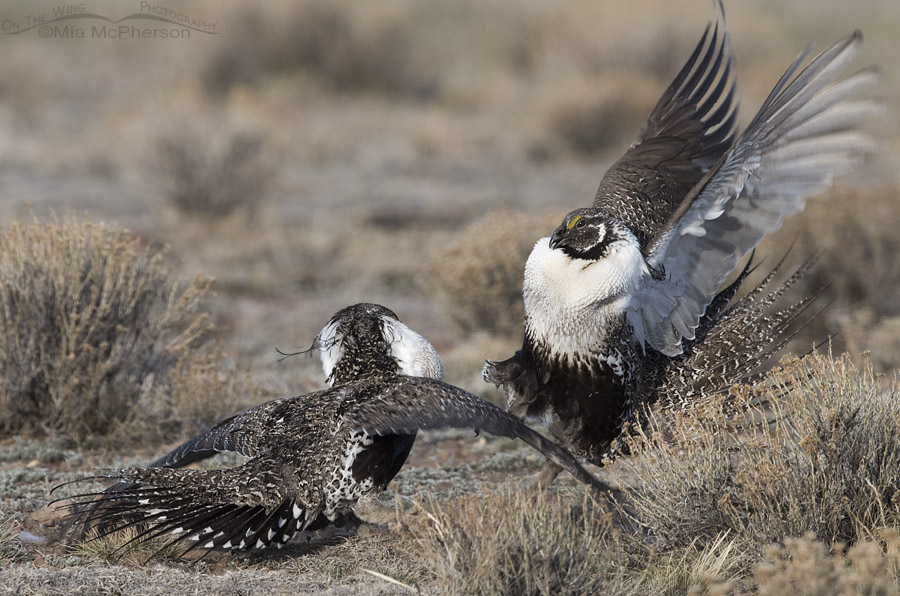 Greater Sage-grouse males sparring at dawn on the lek – Nikon D810, f7.1, 1/1250, ISO 640, Nikkor 500mm VR with 1.4x TC, natural light
Greater Sage-grouse males sparring at dawn on the lek – Nikon D810, f7.1, 1/1250, ISO 640, Nikkor 500mm VR with 1.4x TC, natural light
The second was that they would spar and fight for the right to mate. Dust and bits of vegetation flew, wings flashed as they attempted to dominate each other. Usually the male grouse don’t harm each other but it can happen.
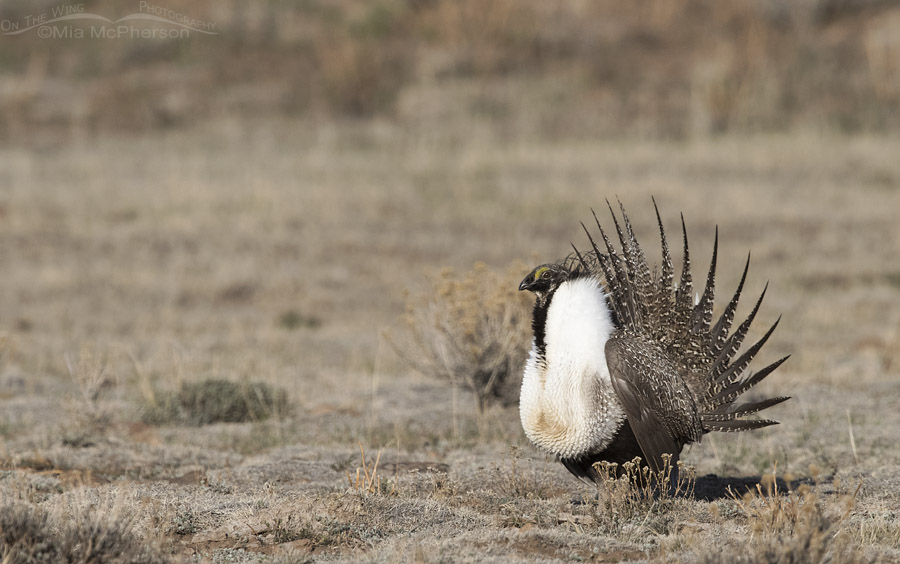 Early morning on a Greater Sage-Grouse lek – Nikon D810, f7.1, 1/2500, ISO 640, -0.3 EV, Nikkor 500mm VR with 1.4x TC, natural light
Early morning on a Greater Sage-Grouse lek – Nikon D810, f7.1, 1/2500, ISO 640, -0.3 EV, Nikkor 500mm VR with 1.4x TC, natural light
That frigid morning I could see dozens of Greater Sage Grouse on the lek, some were on a small hill in the distance and a few came in closer. There were times I watched the ones in the distance as I sipped my coffee from the thermal mug or sat on my hands to warm them back up enough to fire my shutter. You can’t turn on the engine at a lek because that would scare the grouse off of the lek for that morning and prevent them from mating that day. So you sit until the last grouse leaves the lek, rolling the window up at times to stop the frigid air from coming inside.
It is worth it though.
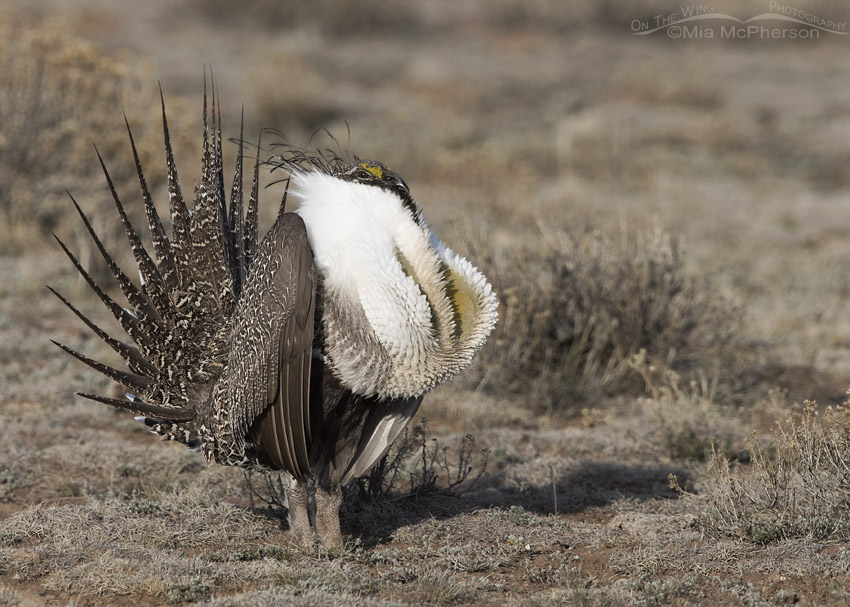 Greater Sage-Grouse male displaying on the sagebrush steppe lek – Nikon D810, f7.1, 1/1250, ISO 400, -0.3 EV, Nikkor 500mm VR with 1.4x TC, natural light
Greater Sage-Grouse male displaying on the sagebrush steppe lek – Nikon D810, f7.1, 1/1250, ISO 400, -0.3 EV, Nikkor 500mm VR with 1.4x TC, natural light
More than worth it to see and document this amazing display on a sage grouse lek. To watch as the males attract the females in a dance that has been going on for eons. To hear their calls and watch them mate.
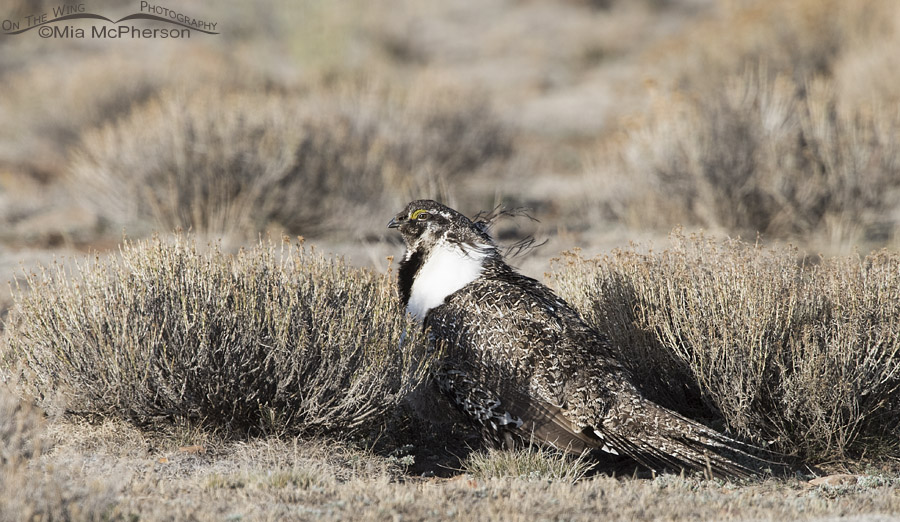 Greater Sage-Grouse male resting on the lek – Nikon D810, f7.1, 1/800, ISO 400, Nikkor 500mm VR with 1.4x TC, natural light
Greater Sage-Grouse male resting on the lek – Nikon D810, f7.1, 1/800, ISO 400, Nikkor 500mm VR with 1.4x TC, natural light
The grouse are sagebrush obligates which means they depend on the sage to live. During the winter they eat the sagebrush to survive until spring. Greater Sage-Grouse and their leks are in danger from oil and gas production and development and it is crucial for their survival that action is taken to protect them now so they can thrive on the sagebrush steppe.
The Sage Grouse Initiative is working hard to help save the grouse by developing partnerships with ranchers, agencies, universities, non-profit groups, and businesses that embrace a common vision: wildlife conservation through sustainable ranching.
More must be done though to save the grouse, especially when it comes to the oil extracting industry.
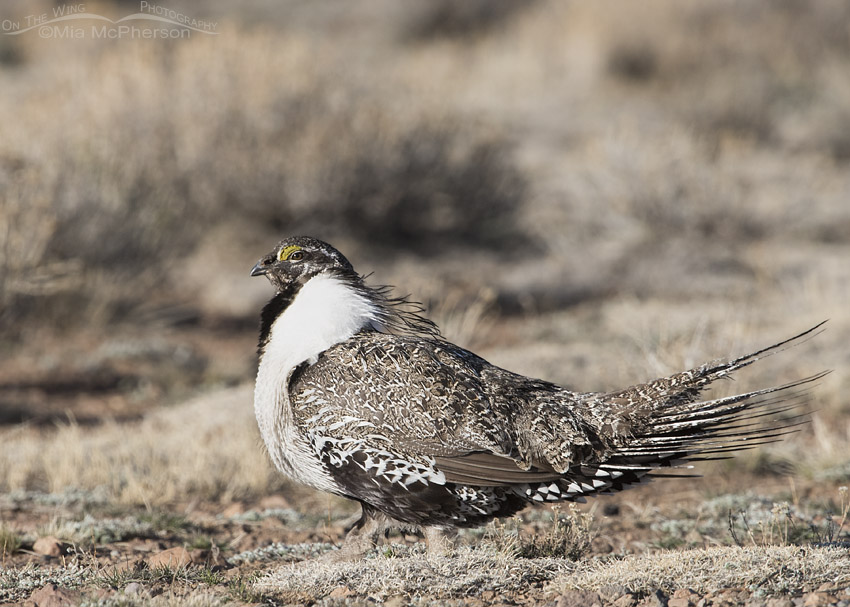 Male Greater Sage-Grouse walking off the lek – Nikon D810, f7.1, 1/1000, ISO 400, Nikkor 500mm VR with 1.4x TC, natural light
Male Greater Sage-Grouse walking off the lek – Nikon D810, f7.1, 1/1000, ISO 400, Nikkor 500mm VR with 1.4x TC, natural light
That frigid morning I took hundreds and hundreds of images of the Greater Sage-Grouse on their lek and watched as the last of the grouse either flew off over the hills or walked away until I could no longer see them in the sagebrush sea.
It was an amazing morning and I felt enchanted and in awe and more determined than ever to keep fighting for our birds, our public lands and nature.
Life is good.
Mia
Click here to see more of my Greater Sage-Grouse photos plus facts and information about this species.
For more information on the Sagebrush Sea food web click here.


Stunning photos and wonderful post. I have shared it with my friends on facebook!
Interesting post and great images. Thanks for both of those links—crazy sounds.
Great series…hope oil stays in the ground and they get to survive….
SUCH a privilege to see.
Absolutely stunning images Mia. Color. Me green with envy.
Ha! Very cool! They look like they’re at a party dancing!
What beautiful birds & wonderful photos! Thank you.